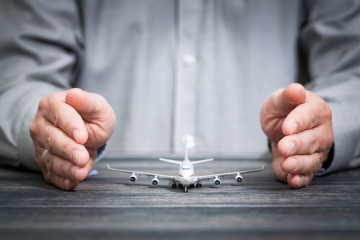Flying on an airplane for the first time — or the first time in a long while — can be an exciting, life-changing adventure. But it can also be incredibly stressful.
You want to head for the gate with the swagger of a seasoned traveler, but that’s hard to pull off when you don’t know how much it costs to check a bag, or what to expect when you go through airport security.
So how can you deal? Reviewing these tips before takeoff can boost your confidence, making your trip easier and more worry-free.
Best advice for first-time flyers
1. Check the airline’s luggage requirements
It’s easy to overpack — but if you do, it could cost you. Before your flight, visit your airline’s website to review luggage size and weight restrictions, as well as baggage fees. While these vary by airline and fare paid, here’s what you can typically bring with a standard fare on a major airline:
- Two carry-on items for free: one full-size carry-on the size of a small rolling suitcase or smaller, and one small personal item, such as a purse or backpack
- One checked suitcase (often, one weighing under 50 pounds) for $25 to $30. Checking additional bags could cost more
If your carry-on bag is too bulky, you may have to pay to check it. Likewise, if your checked bag is over a certain size, you may have to pay a higher-than-usual fee to check it. It’s best to avoid these surprises, if possible.
“If you’re a nervous flyer, little things can really set you off,” says Jackie Sills-Dellegrazie of New York City, founder of the travel blog The Globetrotting Teacher. “Even if it’s not a big deal, and you get to the check-in counter, and they say, ‘Oh, by the way, there’s a $30 bag fee,’ and you weren’t expecting that, that could just be something that rattles you.”
Remember, if you pack light enough, you could avoid baggage fees altogether.
Having an airline credit card can mean waived checked baggage fees, as well.
2. Pack essentials in your carry-on
If you’re packing anything that’s hard to replace — say, prescription medicine, contacts or glasses, or important paperwork — put it in your carry-on bag. This way, you won’t be without that item in the rare event your checked bag goes missing. You’ll also want to pack some in-flight entertainment, such as your laptop, headphones and a book or magazine.
Just make sure you’re following the Transportation Security Administration’s rules for what you can pack. You can’t, for example, bring a big bottle of contact lens solution in your carry-on, but you can bring a 3.4-ounce bottle. And keep in mind that if your carry-on bag is too big to fit under the seat in front of you, you may have to check it. More rules may apply if you’re flying internationally.
“The overhead compartments fill up quickly,” says Jeff Klee, CEO of CheapAir.com, an online travel agency based in Calabasas, California. “If you’re in the back of the plane, you might find that there’s no more room, and you’ll have to do a gate check of your bag at the last minute, which isn’t particularly fun.” Checking your bag at the gate means your full-sized carry-on bag will travel with the other checked bags during the flight, rather than in the overhead bin.
3. Arrive at the airport two hours early
Catching a plane isn’t like catching a bus; it’s a much longer process. In fact, the TSA recommends showing up at least two hours before takeoff for domestic travel, and three hours for international travel.
Ultimately, you need to give yourself enough time to get your boarding pass, check your bags and go through security before your plane starts boarding. Sometimes, that takes 10 minutes. Other times, especially during peak travel times, it can take much longer.
It’s worth keeping in mind that boarding the plane isn’t a free-for-all, either. Airlines typically start boarding passengers 30 minutes before takeoff in groups. Generally, a boarding time will be printed on your ticket.
4. Keep your ID handy
Decades ago, airport security was relatively lax. “There was one point where you could just walk up to a gate, whether you were flying or not, whether you had ID or not,” Klee says. Nowadays, TSA agents check IDs for passengers over 18.
Save time by having your ID card, driver’s license or passport handy as soon as you step foot into the airport. You’ll need it when checking bags and going through security, and you don’t want to hold up the line while rummaging through your wallet.
5. Wear easy-to-remove shoes
Going through airport security might be the most stressful part of flying — but if you know what to expect, the whole rigmarole can feel much less taxing. Typically, unless you have TSA PreCheck or Global Entry, you have to:
- Remove your shoes (unless you’re 12 and under or 75 and older)
- Empty the contents of your pockets and remove your hat, belt, jacket, wallet and bulky jewelry
- Remove your laptop and liquids from your bag
- Send these items — and your carry-on bag — through an X-ray machine
- Walk through a metal detector or a body scanner (or opt for a pat-down)
Preparing for this — say, by wearing shoes you can easily slip on and off and making sure the items in your carry-on are TSA-compliant — can make the process faster.
6. Respect other passengers’ space
These days, flights are generally fully booked, and most seats offer limited legroom. This might stress out your fellow flyers, so be sensitive.
“If any of your stuff or body parts are going into another space that’s not yours, you really have to be mindful of that,” Sills-Dellegrazie says. “It can be as simple as, you put your ponytail over the top of the seat and now it’s hanging … across someone’s TV screen, and you don’t even realize it.”
Similarly, if you wear perfume or cologne, eat smelly foods or listen to loud music, you might unintentionally upset the person sitting next to you. Of course, you can’t plan for everything — maybe you’re traveling with an upset child, for example — but do what you can to avoid an in-flight faux pas.
7. Have a backup plan ready
Now for a game of “worst-case scenario,” first-time flyer edition: What happens if you miss your flight?
First, take a deep breath. If you miss your plane because of unforeseen circumstances, such as a major traffic delay, the airline will often put you on standby for the next flight without charging extra. Just remember that you generally need to notify the airline within a couple of hours of missing your flight to get rebooked for free.
If it looks like you’ll miss a connecting flight, check the smartphone app offered by your airline or the screen in the airport to find out which gate your flight departs from, and whether you’ve actually missed it. If the flight is delayed, you may still have a chance to board. But if you miss the connection and the airline was responsible, you can generally also rebook that flight free of charge — and maybe even get some free meal or hotel vouchers for the hassle.
The key in both cases: Be proactive. Have the airline’s customer service phone number handy in case you get stuck in traffic, so you can call as soon as possible. Or if you’re already at the airport, go to the customer service desk and asking about rebooking. Missing a flight can be a setback, but it doesn’t have to derail your travel plans.


